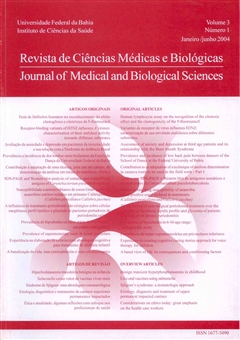Assessment of anxiety and depression at third age patients and its relationship with the Burn Mouth Syndrome
DOI:
https://doi.org/10.9771/cmbio.v3i1.4405Keywords:
Burning Mouth Sindrome, Glossopirose, Anxiety.Abstract
The Burning Mouth Syndrome (BMS) is a condition characterized by burning sensation on the oral tissues without a physical cause. This condition affects especially mild menopausal woman over 50 years old. Many factors have been suggested as possible etiology of this condition. The importance of psychological factors such as anxiety and depression on the development of this condition It has been extensively discussed. 28 This paper aim to evaluate the prevalence of BMS and its relation to the degree of anxiety and depression in females over 60 years old living in hostels in the city of Salvador, Bahia, Brazil using the Hospital Anxiety and Depression Scale - HADS. Fifty-Seven of 60 mild menopausal women over sixty years old answered the HADS questionnaire and entered the study. The results showed that the majority (54.4%) demonstrated a moderate level of anxiety and a low level of the depression. Three patients (5.26%) out of 57 women complained of burning feeling in the mouth and 83,3% of them showed moderate to severe degree of anxiety. The majority (66.6%) of the patients of this sample presented small tendency to depression. The results of the present study may allow concluding that anxiety may be one of the factors influencing the development of the BMS. Characteristics of the BMS and other possible etiologic factors observed on this sample are also discussed.Downloads
Download data is not yet available.
Downloads
Published
2004-01-01
How to Cite
Nery, F. S., Lauria, R. A., Sarmento, V. A., & Oliveira, M. das G. A. (2004). Assessment of anxiety and depression at third age patients and its relationship with the Burn Mouth Syndrome. Journal of Medical and Biological Sciences, 3(1), 20–29. https://doi.org/10.9771/cmbio.v3i1.4405
Issue
Section
ORIGINAL ARTICLES
License
The Journal of Medical and Biological Sciences reserves all copyrights of published works, including translations, allowing, however, their subsequent reproduction as transcription, with proper citation of source, through the Creative Commons license. The periodical has free and free access.


